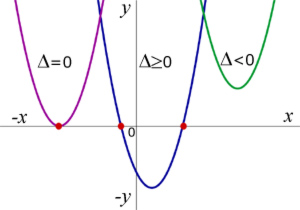Home >> PURE MATHS, Algebra, quadratic equations
Introduction
The general form of a quadratic equation is:
![]()
where a, b & c are constants
The expression ![]() is called the discriminant and given the letter Δ (delta).
is called the discriminant and given the letter Δ (delta).
All quadratic equations have two roots/solutions.
These roots are either REAL, EQUAL or COMPLEX*.
*complex - involving the square root of -1


Solution by Factorising - This is best understood with an example.
Example
Solve: ![]()
You must first ask yourself which two factors when multiplied will give 12 ?
The factor pairs of 12 are : 1 x 12, 2 x 6 and 3 x 4
You must decide which of these factor pairs added or subtracted will give 7 ?
| 1 : 12 ...gives 13, 11 |
| 2 : 6 .....gives 8, 4 |
| 3 : 4 .....gives 7, 1 |
![]()
Which combination when multiplied makes +12 and when added gives -7 ?
These are the choices:
| (+3)(+4) |
| (-3)(+4) |
| (+3)(-4) |
| (-3)(-4) |
Clearly, (-3)(-4) are the two factors we want.
therefore,
![]()
Now to solve the equation,
factorising, as above putting the function equal to zero,
![]()
either,
![]()
or
![]()
for the equation to be true.
So the roots of the equation are: ![]()
Completing the Square
This can be fraught with difficulty, especially if you only half understand what you are doing.
The method is to move the last term of the quadratic over to the right hand side of the equation and to add a number to both sides.
The reason for doing this is so the left hand side can be factorised as the square of two terms.
example
![]()
![]()
![]()
![]()
![]()
![]()
![]()
![]()
![]()
However, there is a much neater way of solving this type of problem.
That is by remembering to put the equation in the following form:
![]()


using the previous example,

Using the Formula
The two solutions of quadratic equations in the form:
![]()
are given by the formula:

Example
Find the two values of x that satisfy the following quadratic equation:

[ About ] [ FAQ ] [ Links ] [ Terms & Conditions ] [ Privacy ] [ Site Map ] [ Contact ]
